This education unit kicks off a new course for the FIBO Data Model.
Building an Enterprise Model is a huge challenge, irrespective of the notation, Entity-Relationship or Ontology Web Language, OWL.
The vision is to receive an immediate return on investment, using the reference model as an encyclopedia of building blocks, leveraging design patterns as blueprints for Solution Architecture, reaping benefits from day one.
Solution Architects’ way is to follow the data model packages rather than fully rationalizing the concept hierarchies. We start with the package structure, and installments describe individual FIB-DM packages.
This pages has the PowerPoint and class video with a transcript.
Watch the video first, because the narrative provides explanations for the charts and diagrams. You can download the PDF here.
Transcript
Hello, welcome back to FIB-DM, the Financial Industry Business Data Model. This lesson kicks off a whole new education track: Semantics for Project Architects
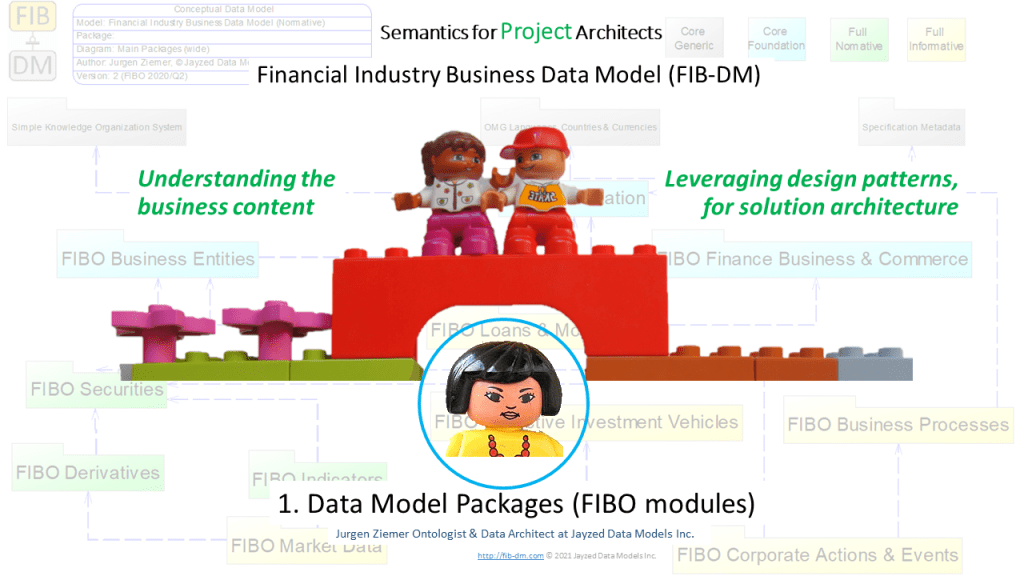
It’s about understanding the business content and leveraging design patterns for Solution Architecture. In this track, we explore the data model packages derived from FIBO modules in-depth.
The FIBO and FIB-DM are the industry-standard. The Financial Industry Business Ontology, FIBO is the blueprint for Enterprise Ontologies and the Knowledge Graph.
One thousand, three hundred users already downloaded the ontology-derived Financial Industry Business Data Model. Education Resources cover model structure, concept hierarchies, and the transformation process.
The intended audience for this course is data architects, stakeholders, and oncologists. The new role here is the Project Data Architect, experienced in logical and physical data modeling. You want to copy design solutions for your department or sub-domain database. As the Enterprise Data Architect experienced in Industry Reference Models, you want to customize the industry-standard for your organization. Stakeholders want immediate returns without a huge upfront investment. Finally, the ontologist is responsible for operational and enterprise/knowledge graph ontology design. You want to understand the FIBO modules.
Building an Enterprise Model is a huge challenge.
This is irrespective of the notation, whether it’s Entity-Relationship or Ontology Web Language, OWL. Customizing the industry-standard reference model Is herculean labor.
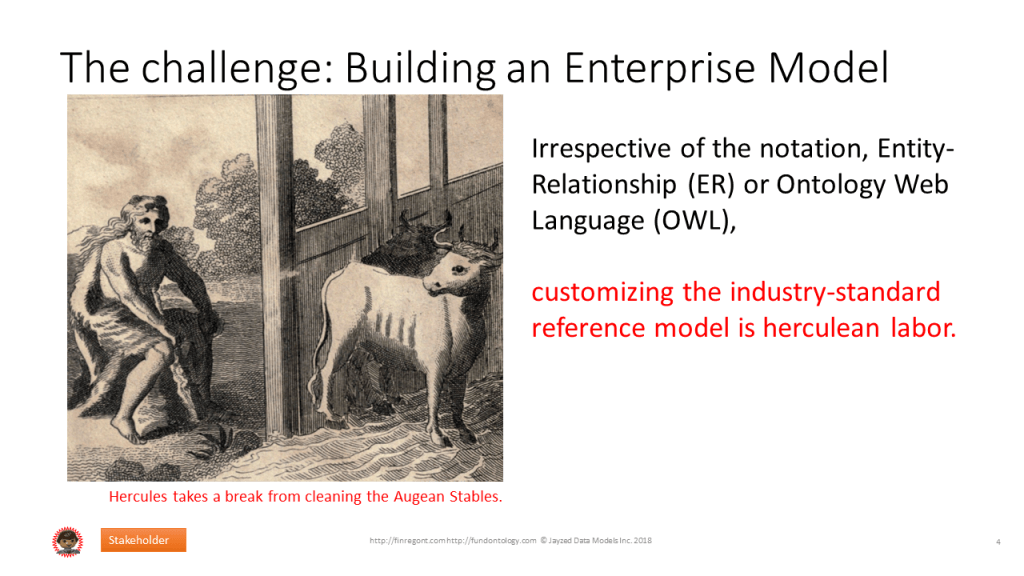
The vision is to receive an immediate return on investment, using the reference model as an encyclopedia of building blocks, leveraging design patterns as blueprints for Solution Architecture, reaping benefits from day one.
The way is a two-pronged learning approach – the key to the industry-standard. Enterprise Architecture focuses on the hierarchies, the 15 concepts, and their associative entities. Solution Architecture focuses on FIB-DM packages, the FIBO modules for the project, not the whole model.
This is a new business-driven 12 lesson education series. The Enterprise Data Architect rationalizes the whole model, traversing the 15 concept hierarchies and the associative entities.
On the other hand, the Project Data Modeler wants to copy blueprints and design patterns for a specific business solution. The Project/Solution track teaches the business content in detail. You deep dive into packages relevant to your project. There shall be 12 units, roughly 30 minutes in lecture. In a class that would be one or two hours with follow- along and Q&A.
The diagram here is FIB-DM in PowerDesigner. We have the main package diagram showing the package dependencies. The education modules follow the dependencies from root to leaf. First, we’re starting with upper ontology derived modules for SKOS, Languages, Currencies & Countries, Specification Metadata, followed by Foundation, Business Entities, and Finance Business and Commerce – the Core Foundation model.
Then comes Loans & Mortgages, and then from the Full Model, FIBO Securities, Indicators & Indices, and derivatives. In the Informative Model, Collective Investment Vehicles, also known as Funds, Market Data, Business Processes, and Corporate Actions.
Monsters!
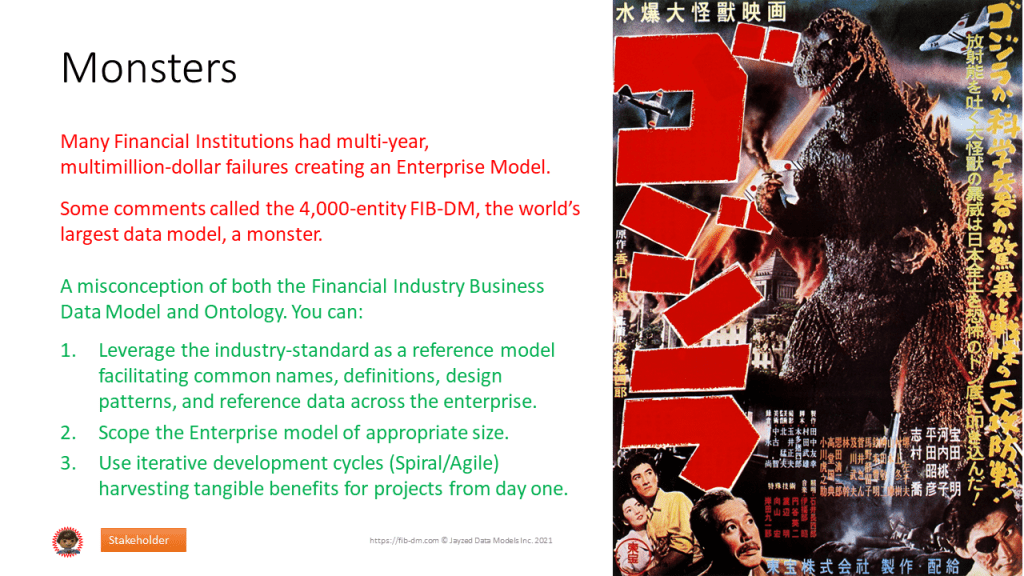
Many financial institutions had multi-year and multi-million dollar failures, creating an enterprise model. Some comments called the 4000-entity FIB-DM, the World’s largest data model, a monster. This is a misconception of both the Financial Industry Business Data Model and Ontology.
You can leverage the industry-standard as a reference model, facilitating common names, definitions, design-patterns, and reference data across the enterprise. Scope the Enterprise Model with an appropriate size, and use Iterative development cycles as in Spiral or Agile, harvesting tangible benefits for projects from day one.
Frankly, an Encyclopedia can’t be too big.
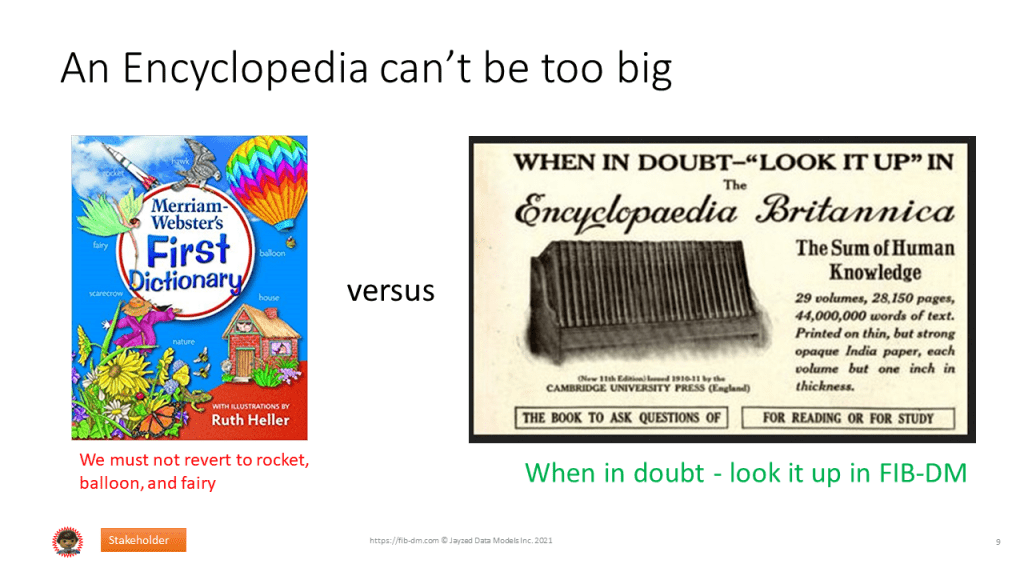
There’s no need to revert to rocket, balloon, and fairy instead of using the Encyclopedia Britannica. The same motto applies to data models: When in doubt – look it up in FIB-DM!
Now, FIB-DM ships in two models, the Normative and the Informative.
You’re probably already familiar with the Open-source Core, part of the Normative model, comprising Foundation, Business Entities, Finance Business & Commerce, Languages, Countries, and Currencies. The Full Version, based on 2020/Q4 Production, adds another thousand entities in modules for Securities, Indicators & Indices, and Derivatives.
Finally, the Informative Model, derived from FIBO Development, adds another 2000 entities in Loans, Corporate Actions & Events, Collective Investment Vehicles (also known as Funds), Market Data, and Business Processes. As new modules enter FIBO Development, Informative modules become Normative.
How do we use the Informative FIBO Data Model?
Our goal is to leverage for the department, project, and application, and our method is to derive. We adhere to the industry standard; in other words, we derive from FIBO Production first, and we consider FIBO Development.
For FIB-DM, I recommend an iterative development process. You’re probably familiar with the Spiral curve, determine objectives, analyze and mitigate risk, develop and test, and plan the next iteration. Also, there’s typically a wedge of increasing prototypes. For FIB-DM, we want to build something concrete while we’re learning the model. An approach could be to start with the Legal Entities and then proceed to Mortgages, Cards, and other modules. So, the cost for the first iterations remains low and under control. Deliverables provide a cumulative benefit.
All data model Education Resources come with Info Cards. We have the title and the front page of the deck. The resource may be available as a PowerPoint, video, article, or white paper. For the intended audience, the main audience with the green circle, and others, the lesson is optional.
This is the education path for Project Architects. You should watch and study the general introduction to the data model, Finance, and applicable the mid-size, large, or extra-large bank, first.
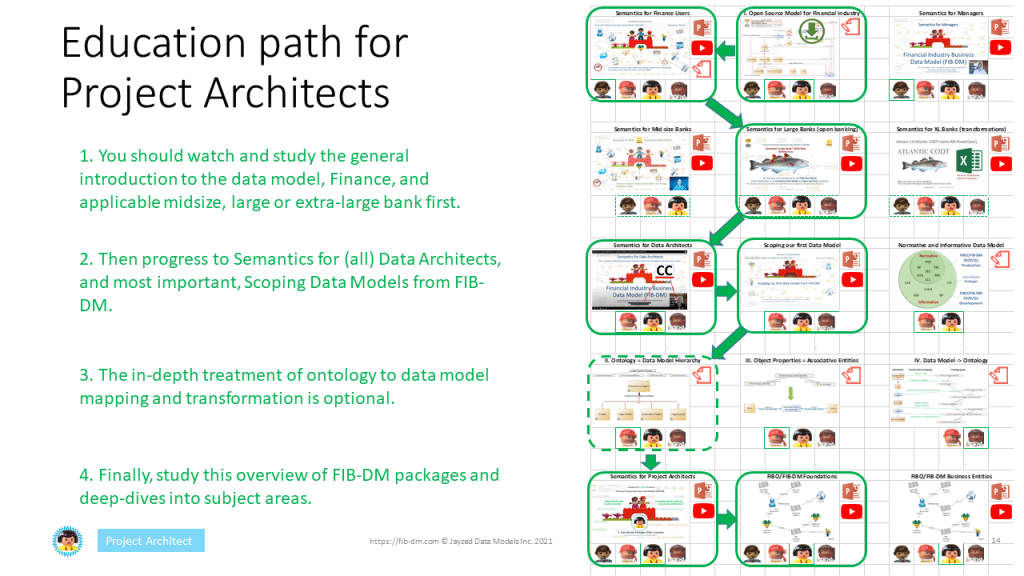
Then you progress to “Semantics for (all) Data Architects,” and most important, “Scoping Data Models from FIB-DM.” The in-depth treatment of ontology to data model mapping and transformation, these articles are optional. Finally, you study this overview of FIB-DM packages and deep dive into Subject Areas.
For further resources and suggested next steps: Visit the FIB-DM website for PowerPoints, articles, and diagrams. Follow the LinkedIn page for discussion, and subscribe to the YouTube channel.
You can download and evaluate the thousand-entity core model, and when you’re ready upgrade to the latest 3000-entity, Full Version.
Please send me an email if you have any questions or like to schedule an overview.
Thanks.